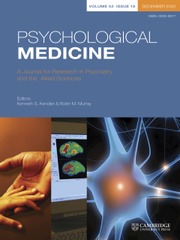Article contents
Dynamic association of the first identifiable symptom with rapidity of progression to first-episode psychosis
Published online by Cambridge University Press: 20 September 2021
Abstract
Rapid progression from the first identifiable symptom to the onset of first-episode psychosis (FEP) allows less time for early intervention. The aim of this study was to examine the association between the first identifiable symptom and the subsequent speed of illness progression.
Data were available for 390 patients attending a catchment-based early intervention service for FEP. Exposure to non-psychotic and subthreshold psychotic symptoms was retrospectively recorded using semi-structured interviews. Outcomes following the onset of the first identifiable symptom were (1) time to onset of FEP and (2) symptom incidence rate (i.e. number of symptoms emerging per person-year until FEP onset). These outcomes were respectively analyzed with Cox proportional hazards and negative binomial regressions.
After Bonferroni correction, having a subthreshold psychotic (v. non-psychotic) symptom as the first symptom was not associated with time to FEP onset [hazard ratio (HR) = 1.39; 95% CI 0.94–2.04] but was associated with higher symptom incidence [incidence rate ratio (IRR) = 1.92; 95% CI 1.10–3.48]. A first symptom of suspiciousness was associated with shorter time to FEP onset (HR = 2.37; 95% CI 1.38–4.08) and higher symptom incidence rate (IRR = 3.20; 95% CI 1.55–7.28) compared to other first symptoms. In contrast, a first symptom of self-harm was associated with lower symptom incidence rate (IRR = 0.06; 95% CI 0.01–0.73) compared to other first symptoms. Several associations between symptoms and illness progression were moderated by the age at symptom onset.
Appreciating the content and timing of early symptoms can identify windows and treatment targets for early interventions in psychosis.
Information
- Type
- Original Article
- Information
- Copyright
- Copyright © The Author(s), 2021. Published by Cambridge University Press
References
- 5
- Cited by


